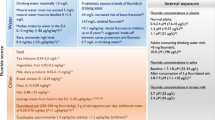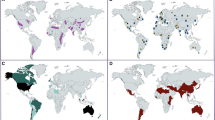Abstract
Levels of mercury (Hg), selenium (Se), iron (Fe), rubidium (Rb), and zinc (Zn) were measured in the pituitary gland to assess the possibility of a potential difference in the environmental Hg exposure of Alzheimer's disease (AD) patients and control subjects and levels of other elements of interest in AD. The pituitary gland has been established as a good predictor of environmental Hg exposure. Neutron activation analysis was utilized to determine levels of these elements in pituitary glands of 43 AD subjects and 15 control subjects. No significant differences were observed between the AD and control means for these five elements. The sole significant Pearson's correlation involving Hg was the established correlation with Se, indicative of the detoxification of Hg. The absence of a statistical difference between AD and control pituitary gland Hg levels suggests AD patients do not have an excessive environmental exposure to Hg compared to controls.
Similar content being viewed by others
References
A. Ahlmark, Poisoning by methyl mercury compounds,Br. J. Ind. Med. 5, 117–119 (1948).
L. Kosta, A. R. Byrne, and V. Zelenko, Correlation between selenium and mercury in man following exposure to inorganic mercury,Nature,254, 238–239 (1975).
M. Nylander and J. Weiner, Mercury and selenium concentrations and their interrelations in organs from dental staff and the general population,Br. J. Ind. Med. 48, 729–734 (1991).
P. Störtebecker, Mercury poisoning from dental amalgam through a direct nose-brain transport,Lancet 1, 1207 (1989).
L. J. Hahn, R. Kloiber, M. J. Vimy, Y. Takahashi, and F. L. Lorscheider, Dental “silver” tooth fillings: a source of mercury exposure revealed by whole-body image scan and tissue analysis,FASEB J. 3, 2641–2646 (1989).
L. J. Hahn, R. Kloiber, R. W. Leininger, M. J. Vimy, and F. L. Lorscheider, Whole-body imaging of the distribution of mercury released from dental fillings into monkey tissues,FASEB J. 4, 3256–3260 (1990).
M. Nylander, L. Friberg, D. Eggleston, and L. Bjorkman, Mercury accumulation in tissues from dental staff and controls in relation to exposure,Swed. Dent. J. 13, 235–243 (1989).
J. A. Weiner and M. Nylander, The relationship between mercury concentrations in human organs and different predictor variables,Sci. Total Environ. 138, 101–115 (1993).
W. D. Ehmann, W. R. Markesbery, M. Alauddin, T. I. M. Hossain, and E. H. Brubaker, Brain trace elements in Alzheimer's disease,Neurotoxicology 7, 197–206 (1986).
C. M. Thompson, W. R. Markesbery, W. D. Ehmann, Y. X. Mao, and D. E. Vance, Regional brain trace-element studies in Alzheimer's disease,Neurotoxicology 9, 1–7 (1988).
D. Wenstrup, W. D. Ehmann, and W. R. Markesbery, Trace element imbalances in isolated subcellular fractions of Alzheimer's disease brains,Brain Res. 533, 125–131 (1990).
D. L. Samudralwar, C. C. Diprete, B. F. Ni, W. D., Ehmann, and W. R. Markesbery, Elemental imbalances in the olfactory pathway in Alzheimer's disease,J. Neurol. Sci. 130, 139–145 (1995).
S. R. Saxe, M. W. Wekstein, R. J. Kryscio, R. G. Henry, C. R. Cornett, D. A. Snowdon, University of Kentucky, unpublished data (1998).
G. McKhann, D. Drachman, M. Folstein, R. Katzman, D. Price, and E. M. Stadlan, Clinical diagnosis of Alzheimer's disease: Report of the NINCDS-ADRDA Work Group under the auspices of Department of Heath Services Task Force on Alzheimer's disease,Neurology 34, 939–946 (1984).
Z. S. Khachaturian, Diagnosis of Alzheimer's disease,Arch. Neurol. 42, 1097–1104 (1985).
S. S. Mirra, A. Heyman, D. McKeel S. M. Sumi, B. J. Crain, L. M. Brownlee, et al., The consoritum to establish a registry for Alzheimer's disease (CERAD), Part II. Standardization of the neuropathologic assessment of Alzheimer's disease,Neurology 41, 479–486 (1991).
R. A. Nadkarni and W. D. Ehmann, Determination of trace elements in biological standard kale by neutron activation analysis,J. Radioanal. Chem. 3, 175–185 (1969).
E. L. Kanabrocki, J. Greco, L. A. Graham, E. Kaplan, M. E. Rubnitz, Y. T. Oester, et al., Trace elements in human pituitary,Int. J. Nuclear Med. Biol. 3, 73–76 (1976).
I. Falnoga, I. Kregar, M. Škreblin, M. Tušek-Žnidarič, P. Stegnar, Interactions of mercury in rat brain,Biol. Trace Element Res. 37, 71–83 (1993).
O. Thorlacius-Ussing, M. Gregersen, and N. Hertel, The concentration of twelve elements in the anterior pituitary from human subjects and rats by particle induced X-ray emission (PIXE),Biol. Trace Element Res. 16, 189–202 (1988).
Author information
Authors and Affiliations
Rights and permissions
About this article
Cite this article
Cornett, C.R., Ehmann, W.D., Wekstein, D.R. et al. Trace elements in Alzheimer's disease pituitary glands. Biol Trace Elem Res 62, 107–114 (1998). https://doi.org/10.1007/BF02820026
Received:
Revised:
Accepted:
Issue Date:
DOI: https://doi.org/10.1007/BF02820026




